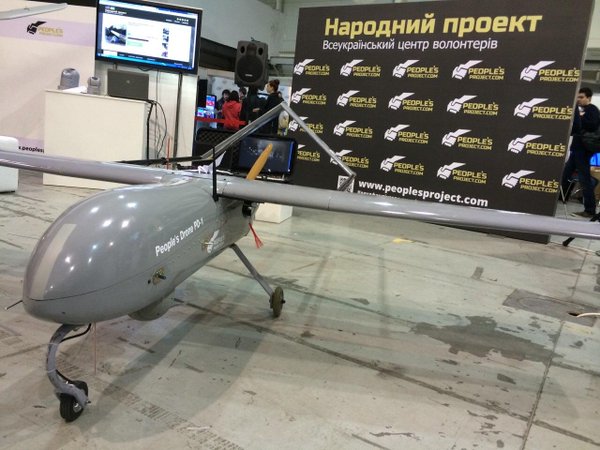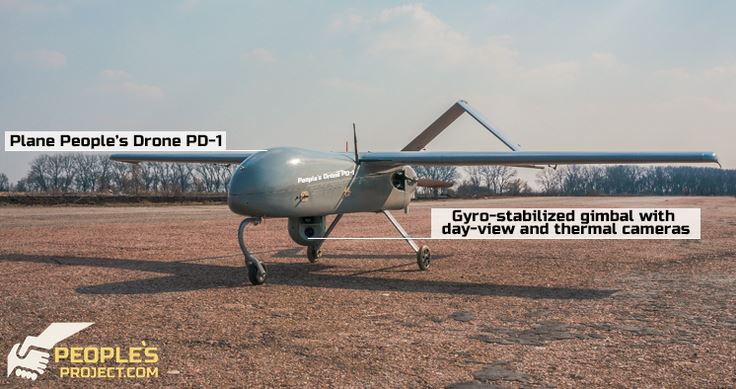1) Growing back bones and skin with stem-cell technology
 Bioengineering Rehabilitation for Wounded. A consequence of war is wounded. This project utilizes stem-cell based technology to regenerate bone and tissue lost as a consequence of being wounded, saving soldiers from permanent disability or amputation of limbs. This innovative project goes beyond the realms of traditional medicine and while the science behind it is complex, basically lost tissue or bone is regenerated from cells harvested from the patient. It has proved so successful that 12 of the 25 men treated (so far) have fully recovered and one even chose to return to the front-line in the Donbas region as soon as he was able.
Bioengineering Rehabilitation for Wounded. A consequence of war is wounded. This project utilizes stem-cell based technology to regenerate bone and tissue lost as a consequence of being wounded, saving soldiers from permanent disability or amputation of limbs. This innovative project goes beyond the realms of traditional medicine and while the science behind it is complex, basically lost tissue or bone is regenerated from cells harvested from the patient. It has proved so successful that 12 of the 25 men treated (so far) have fully recovered and one even chose to return to the front-line in the Donbas region as soon as he was able.
2) A crowd-funded drone
3) A self-developed combat management system with US & Israeli functionality
 ComBat Battlefield Management System. A problem identified during the battle for Donetsk Airport was the coordination, movement and communication of Ukrainian forces and, worse, the problem of friendly-fire. Statistically friendly fire occurs on a battlefield more than 40% of the time. The United States and Israel have developed battle management systems that reduce incidents of friendly fire and ensure operational control of enemy units and machinery. While these foreign systems bring with them many advantages, Ukraine’s volunteers faced two disadvantages - their cost is prohibitive and, even if they were affordable, they cannot be obtained legally. Realizing the pressing need for combat management systems, developers for a system were found in Ukraine. They produced a system which performs the same functions as foreign versions, at relatively little technical cost. This battlefield management system is called ComBat. It allows for combat mission planning, placing intelligence information on a map, co-ordination of units while performing combat missions, and analysis of mistakes by retrieving the history module. All information is relayed between the server and Android devices.
ComBat Battlefield Management System. A problem identified during the battle for Donetsk Airport was the coordination, movement and communication of Ukrainian forces and, worse, the problem of friendly-fire. Statistically friendly fire occurs on a battlefield more than 40% of the time. The United States and Israel have developed battle management systems that reduce incidents of friendly fire and ensure operational control of enemy units and machinery. While these foreign systems bring with them many advantages, Ukraine’s volunteers faced two disadvantages - their cost is prohibitive and, even if they were affordable, they cannot be obtained legally. Realizing the pressing need for combat management systems, developers for a system were found in Ukraine. They produced a system which performs the same functions as foreign versions, at relatively little technical cost. This battlefield management system is called ComBat. It allows for combat mission planning, placing intelligence information on a map, co-ordination of units while performing combat missions, and analysis of mistakes by retrieving the history module. All information is relayed between the server and Android devices.
4) A remote-controlled fire complex that doesn't give away Ukrainian positions
 Sabre Remote Weapon Station. Sabre is a Ukrainian-developed automated remote controlled fire complex designed to be installed on fixed objects or special transport. This device is coordinated by using the remote control and monitor, allowing it to be employed in a fire fight from a distance, protecting the soldier operating it from a safer location. The combat platform can be installed at checkpoints and at the border as well as various other areas. Often UAVs are launched by the terrorists on reconnaissance to ascertain Ukrainian army positions. Soon after, bombardment with grad rockets in an attempt to destroy those positions begins. The Sabre gun turret gives a soldier the ability to shoot down a UAV as it approaches, establish the position of enemy artillery while making it near impossible for them to detect the Ukrainian position.
Sabre Remote Weapon Station. Sabre is a Ukrainian-developed automated remote controlled fire complex designed to be installed on fixed objects or special transport. This device is coordinated by using the remote control and monitor, allowing it to be employed in a fire fight from a distance, protecting the soldier operating it from a safer location. The combat platform can be installed at checkpoints and at the border as well as various other areas. Often UAVs are launched by the terrorists on reconnaissance to ascertain Ukrainian army positions. Soon after, bombardment with grad rockets in an attempt to destroy those positions begins. The Sabre gun turret gives a soldier the ability to shoot down a UAV as it approaches, establish the position of enemy artillery while making it near impossible for them to detect the Ukrainian position.
5) A skin bank for treating burns where material can be harvested from any donor
 Skin Bank. Endorsed by Ukraine’s First Lady Maryna Poroshenko, this initiative, open to both military and civilians, is like the Bioengineering Rehabilitation for Wounded project in that it harnesses stem-cell technology, in this case for the treatment of burns – thermal or chemical. What makes the project particularly innovative is the cells to cultivate the skin needed by the patient can be harvested from any donor. Taken by a liposuction, the cellular material is then modified into a form that means it will not be rejected by the patient’s body. Two patients, both civilian, are undergoing treatment so far, one man burned during the EuroMaidan protests and a second man injured near Odesa last November in a fiery car crash.
Skin Bank. Endorsed by Ukraine’s First Lady Maryna Poroshenko, this initiative, open to both military and civilians, is like the Bioengineering Rehabilitation for Wounded project in that it harnesses stem-cell technology, in this case for the treatment of burns – thermal or chemical. What makes the project particularly innovative is the cells to cultivate the skin needed by the patient can be harvested from any donor. Taken by a liposuction, the cellular material is then modified into a form that means it will not be rejected by the patient’s body. Two patients, both civilian, are undergoing treatment so far, one man burned during the EuroMaidan protests and a second man injured near Odesa last November in a fiery car crash.
6) A blindage that takes an hour to construct
 People’s Blindage. Initially conditions faced by Ukrainian troops on the front-lines in Donbas could be likened to World War I trench-warfare. Ukraine’s forces were digging trenches to protect themselves not only from enemy fire but also from the weather. The need for adequate shelters was acute. People’s Project volunteers thoroughly researched the issue and found a Ukrainian manufacturer of blindages that could be modified according to need. Two variants were selected for the project. The type 1 module can accommodate up to six people, the type 2 module (living module) up to 12. It takes less than an hour to construct these modules with little or no heavy machinery. Primarily designed as personnel accommodation, they can also be adapted according to need as storage, headquarters, or a communications hub.
People’s Blindage. Initially conditions faced by Ukrainian troops on the front-lines in Donbas could be likened to World War I trench-warfare. Ukraine’s forces were digging trenches to protect themselves not only from enemy fire but also from the weather. The need for adequate shelters was acute. People’s Project volunteers thoroughly researched the issue and found a Ukrainian manufacturer of blindages that could be modified according to need. Two variants were selected for the project. The type 1 module can accommodate up to six people, the type 2 module (living module) up to 12. It takes less than an hour to construct these modules with little or no heavy machinery. Primarily designed as personnel accommodation, they can also be adapted according to need as storage, headquarters, or a communications hub.
7) Mobile military laundries in old trailers
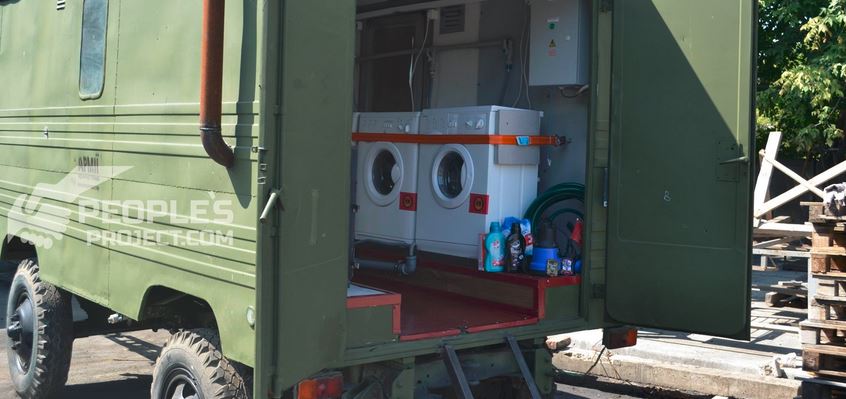 Military Kung. There’s no question war is a dirty business, but it can be a little cleaner. On the battlefield, there is no provision for basic hygiene, not to mention for laundry. With the men often having only one change of military fatigues and living in close quarters, providing field laundries and bathrooms was a priority. The laundries and bathrooms are being made out of old and decrepit KUNGs (military trailers) and are fully self-contained with all the necessary utilities on board.
Military Kung. There’s no question war is a dirty business, but it can be a little cleaner. On the battlefield, there is no provision for basic hygiene, not to mention for laundry. With the men often having only one change of military fatigues and living in close quarters, providing field laundries and bathrooms was a priority. The laundries and bathrooms are being made out of old and decrepit KUNGs (military trailers) and are fully self-contained with all the necessary utilities on board.
8) Armor for military vehicles that protects against missiles
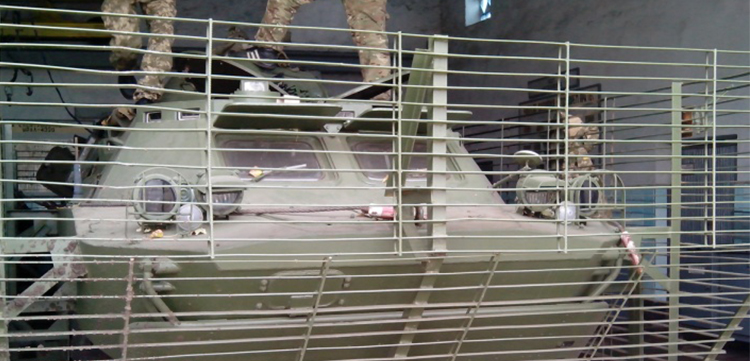 People’s Armor and People’s Armor 2. During warfare, military vehicles are often seriously damaged by fire from mobile anti-tank weapons and different kinds of rocket launchers. The worst is a missile with a cumulative head. These missiles allow for the penetration up to 300 mm of reinforced steel. One of the best protections against cumulative missiles is the use of slatted-armor in the form of anti-cumulative shields. When the missile hits the shield, it explodes at a distance from the external armor of the vehicle, thus the missile's penetration capacity is significantly reduced. The armor saves lives as members of the Mykolaiv-based 79th Brigade can attest to after a shell lodged in between the slats of the armor on one of their vehicles during battle in the ATO zone.
People’s Armor and People’s Armor 2. During warfare, military vehicles are often seriously damaged by fire from mobile anti-tank weapons and different kinds of rocket launchers. The worst is a missile with a cumulative head. These missiles allow for the penetration up to 300 mm of reinforced steel. One of the best protections against cumulative missiles is the use of slatted-armor in the form of anti-cumulative shields. When the missile hits the shield, it explodes at a distance from the external armor of the vehicle, thus the missile's penetration capacity is significantly reduced. The armor saves lives as members of the Mykolaiv-based 79th Brigade can attest to after a shell lodged in between the slats of the armor on one of their vehicles during battle in the ATO zone.
9) Upgrading old Ukrainian Kalashnikovs so they matched the Russian ones
 People’s AK Tuning. Ukraine’s fighters are equipped with out-of-date and almost obsolete Kalashnikovs. While they were a reliable weapon in the 20th century, in the 21st, the original weapon is ineffective in modern, often high-tech warfare. However, Kalashnikovs can be modernized if you add additional components. The war in Eastern Ukraine – is a “Kalashnikov vs Kalashnikov” fight at its most basic level. However, the Kalashnikovs which the Russian militants are equipped with have been upgraded. In short it is modernized Russian guns against out-of-date Ukrainian. The People’s AK Tuning project sought to address this imbalance crowdfunding for modular handguards, fore-grips, ergonomic pistol grips, red dot sights and dual magazine clips.
People’s AK Tuning. Ukraine’s fighters are equipped with out-of-date and almost obsolete Kalashnikovs. While they were a reliable weapon in the 20th century, in the 21st, the original weapon is ineffective in modern, often high-tech warfare. However, Kalashnikovs can be modernized if you add additional components. The war in Eastern Ukraine – is a “Kalashnikov vs Kalashnikov” fight at its most basic level. However, the Kalashnikovs which the Russian militants are equipped with have been upgraded. In short it is modernized Russian guns against out-of-date Ukrainian. The People’s AK Tuning project sought to address this imbalance crowdfunding for modular handguards, fore-grips, ergonomic pistol grips, red dot sights and dual magazine clips.
10) For the first time ever, provided thermal scopes to Ukraine's military, sourcing from Ukrainian-made parts
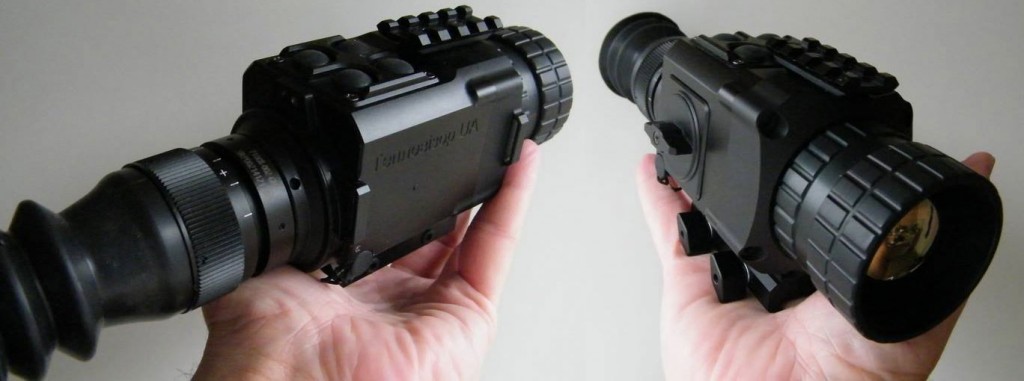 People’s Thermal Weapon Scope. Ukrainian-developed thermal weapons scopes are playing a key role in the war in the east of the country and, more importantly, saving lives. Prior to volunteer intervention, Ukraine did not provide this technology to its military. A thermal vision device, such as a scope, is basically a specialized video camera with a high-contrast micro-display. Unlike conventional cameras, a thermal weapon scope does not see light. It detects heat, and heat is radiated by almost any object, including cold objects. Grass, light bush, smoke, dust, fog, rain, and snow do not interfere with thermal vision’s operation. A person will be seen with clarity in any of these conditions, while other types of night vision device will be blind or display a barely visible silhouette. A thermal weapon scope is the best detection and targeting technology available and is capable of detecting a source of thermal radiation to a distance of a mile or more. The sights have been sourced from Kyiv-based Thermal Vision Technologies, which produces them under the brand name Archer and Ukrainian company Teplovizor UA, which manufactures a model similar to that produced by a Canadian company with a price tag of about US$12,000 – its Ukrainian counterpart is only $4900. Others have been sourced from Lithuania manufacturer Pulsar.
People’s Thermal Weapon Scope. Ukrainian-developed thermal weapons scopes are playing a key role in the war in the east of the country and, more importantly, saving lives. Prior to volunteer intervention, Ukraine did not provide this technology to its military. A thermal vision device, such as a scope, is basically a specialized video camera with a high-contrast micro-display. Unlike conventional cameras, a thermal weapon scope does not see light. It detects heat, and heat is radiated by almost any object, including cold objects. Grass, light bush, smoke, dust, fog, rain, and snow do not interfere with thermal vision’s operation. A person will be seen with clarity in any of these conditions, while other types of night vision device will be blind or display a barely visible silhouette. A thermal weapon scope is the best detection and targeting technology available and is capable of detecting a source of thermal radiation to a distance of a mile or more. The sights have been sourced from Kyiv-based Thermal Vision Technologies, which produces them under the brand name Archer and Ukrainian company Teplovizor UA, which manufactures a model similar to that produced by a Canadian company with a price tag of about US$12,000 – its Ukrainian counterpart is only $4900. Others have been sourced from Lithuania manufacturer Pulsar.

